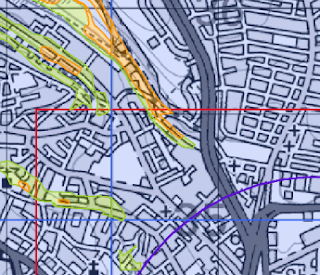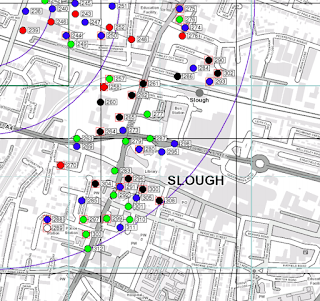Prolog
It means that between 3% and 5% of the home in your area are above 200 Becquerels m-3 .The conclusion of this page is “if in doubt” test. Get a testing kit from UK Radon (Part of Government) and follow their instructions. Our professional advice is not to test for less than 3 months. It is quite likely to give and inaccurate result. Read on for more delicious boffin waffle:
Introduction
You are reading this because Radon is dangerous. Radon is a radioactive gas, and small percentages in the air that you are breathing can be disaster. But how small? And what does 3 to 5 % mean?
Every building contains radon but the levels are usually low. The chances of a higher level depend on the type of ground. UK Health Security Agency has published a map showing where high levels are more likely.
Above from UK Radon.It is boradley correct, but as well as the “type of ground” the type of building is very important.
Becquerels
The “action” level for Radon is 200 Becquerels m-3 At this point we don’t really need to understand what that means, just that is exists.
What Does 3% to 5% Mean?
It means that between 3% and 5% of the home in your area are above 200 Becquerels m-3 (the action level). The worst it could be is 30% over the level, and best is 1% or less.
So that is a bit confusing isn’t it. Is you home dangerous or not? Well really we would need to know a lot about you building before we could make a guess. Not only what radon was coming out of the ground (difficult to measure), but also how much of it leaks out (also difficult to measure).
Type of Building
Good – If the house is a modern building with a radon protection barrier, sump, and other features then chances are that you indoor air quality will be good (with regards to radon) and you will be below action level. But the bottom line is you do not know if you are safe unless you test. Perhaps the builders made some mistakes, perhaps they didn’t follow the plans, or the building inspector forgot to check. . . .
Bad – If the house is old, and maybe has a suspend timber floor, with no damp proof course, then radon can get in to the house from the ground. However, if the house also has old leaky windows and drafts coming under the door, then this may help keep radon levels lower, as they will have less chance build up. Things like positive input ventilation, or a wood burner, or a vented tumble drier can also affect air flow through the house, and affect radon levels. But the bottom line is you do not know if you are safe unless you test.
Ugly – An old house, with no damp proof course which as be subsequently upgraded to include double glazing, draft proofing and uses combustion appliances with balanced flues, will experience very little air flow, whilst allowing ground gases (including radon) in to the building. Very very much worth urgently doing some testing if you are in this situation.
Conclusion
The bottom line is you do not know if you are safe unless you test.
There are too many variables to predict accurately what the radon level in a house will be. All we know from the 3% to 5% bracket, is that “some” houses in your area have a problem.
Construction techniques, building age, choice of appliances, choice of heating systems, and user behaviour all play a role in radon levels. The bottom line is you do not know if you are safe unless you test.
When you do the test get you kits direct from UK radon:
https://www.ukradon.org/services/orderdomestic
They are the official government labs, and will not recommend test period of less than 90 days. Do not test for less than 90 days because of all the variables, as mentioned above, you need to measure for a long period to make sure results are representative.




.png)
.png)
.png)


